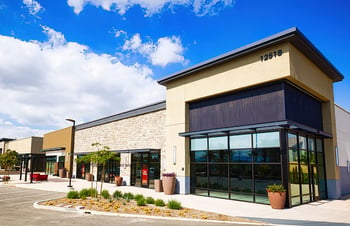 Lucy Waters - Managing Director of Aria Finance
Lucy Waters - Managing Director of Aria Finance
It's been a while since borrowers have had much in the way of good news. Therefore, you can understand the buzz surrounding the recent falls in mortgage rates.
Whilst borrowers will likely pay much more than they were when they come to remortgage, the outlook is looking much better than it was last year.
Swap rates have fallen significantly over the past few months, giving residential and buy-to-let lenders enough wiggle room to sharpen their ranges significantly. A couple of residential lenders have even broken below the 4% barrier, something that would have seemed almost impossible even a few weeks ago.
However, while homeowners and landlords are benefitting from the sharp fall in swap rates, commercial mortgage customers aren't. But why? The most obvious reason, of course, is that there are many more lenders in the residential and buy-to-let markets.
UK Finance, the trade body, puts the number operating in both sectors at around 60-70, whereas there are fewer operating in the commercial mortgage market.
When you have such intense competition, as there is in the residential and buy-to-let markets, it acts as a natural cap on rates as lenders fight each other for business. That effect is watered down in the commercial mortgage market, where competition is less fierce.
Another reason I believe we have not seen a so-called 'rate war' in the commercial mortgage space is down to the structure of the sector itself. If you look at the residential mortgage market, there are not only a large number of lenders, there are also a large variety of business and funding models.
For example, you have building societies, which rely on savings deposits; non-bank lenders, which fund through wholesale markets; challenger banks, which use both; and the high street, which have deep and varied funding sources.
From a market perspective, that has many advantages. If, for example, the wholesale markets dry up, non-bank lenders would suffer. But you may find building societies, which are reliant on saving deposits to fund lending, are less affected. If you look at the commercial mortgage market, on the other hand, it is dominated by a small number of challenger banks with very similar business models and funding sources.
These lenders have been fantastic over the past 12-18 months and have demonstrated their commitment to the sector time and time again.
The commercial mortgage market is a better place for them. But my point is the uniformity of lender profiles in the commercial mortgage market may be holding the sector back and hindering the rate cuts we have seen in the residential and buy-to-let spaces.
Before pressing on, it's worth quickly recapping how challenger banks raise money for new lending.
While they can and do tap up the wholesale markets, they usually do so on less favourable terms than the high street lenders. Naturally, that makes them more reliant on savings deposits to fund lending.
As a result, it means their pricing is less affected by swap rates than a lender that exclusively raises their funding from the money markets.
It also means that their funding costs rise in line with savings rates which, as we have seen, are higher now than they have been for more than a decade.
Therefore, in the current environment, commercial mortgage lenders have little choice but to keep their rates higher. Commercial mortgages are also 100% risk-weighted, meaning that the cost of capital is higher.
The issue is commercial mortgage borrowers, understandably, don't want to borrow at 8-9%. They see what's happening in the residential and buy-to-let markets and decide they'll weather the storm until commercial mortgage lenders follow suit. This is impacting volumes.
So, what can give the commercial mortgage market the boost we've all been waiting for? Quite simply, a fall in interest rates. If the Bank of England lower rates, it will bring down the cost of funding for challengerbanks, allowing them to sharpen up their pricing.
A few months ago, I would have said such a scenario was very unlikely, but we've come back from the Christmas break to predictions of as many as rate cuts this year.
I think that may be slightly overoptimistic, but it does feel as though a rate cut is closer that it has been for a long time. Until then, it's likely that the commercial mortgage market will continue to tread water, as it has done for much of the past 6-12 months. But if the BoE does push the big red button on an interest rate cut this year, as expected, we should probably expect activity to pick up rapidly. Here's hoping.
Published in NACFB - February 2024

.png)
.png?width=1000&height=600&name=aria%20(12).png)
.png?width=1000&height=600&name=aria%20(11).png)




